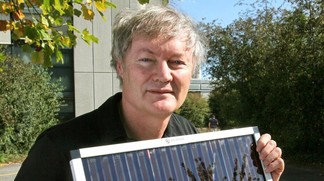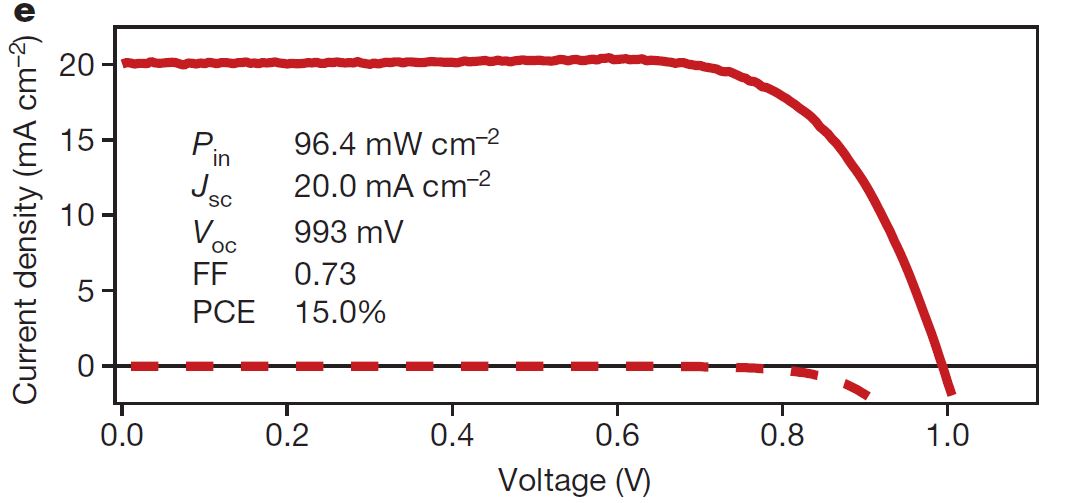This is Science: Simple and Cheap Solar Energy

At the beginning of July 2013, one remarkable article appeared in the journal Nature, the material of which once again proves that there should be cheap and simple solar energy, and, moreover, this matter is already near future.
')
Back in 1988, a young man named Michael Gratzel ( Michael Grätzel ), now a professor at the Lausan Polytechnic School (EPFL, Switzerland), together with Brian O'Regan, suggested an absolutely crazy idea at that time, use dyes in solar batteries to absorb light and transfer the absorbed energy to the semiconductor (later - titanium dioxide). After that, the electron "moves" through the semiconductor until it reaches the anode, and the dye left without an electron (essentially a "hole", in terms of semiconductors) receives it from the I - ions, which, in turn, turn into I 3– ions ( the so-called redox pair), transfer charge to the cathode. As a result, the two contacts have some useful potential difference. Over time, such cells began to be called Gratzel cells or Dye-sensitized solar cell , DSSC (sensitized / dye-activated solar cells).

DSSC Principle ( Source )
And everything would be fine, if not one BUT. From the point of view of physical and chemical laws, the efficiency of such a battery can not exceed 33% - and even then only in theory. The only advantage of this kind of solar cells is their fabulously low production cost compared to silicon, for example. It is worth recalling that in 1991, the world completely relied on the belief in silicon for terrestrial applications (including the emerging class of thin-film technologies) and gallium arsenide (GaAs) for space.

Data collected by the National Institute for Renewable Energy (USA)
It took 25 years of truly titanic efforts (for a long time it was not possible to exceed the threshold of 10%) for 5-6% of the efficiency of conversion of solar energy into electricity turned into almost 15%!
The essence of the perfect discovery is to use a polycrystalline perovskite-like lead compound - CH 3 NH 3 PbI 3 - as a sensitizer and mediator (“hole” conductor). This material is actually chemically deposited - does not require vacuum installations - on the surface of mesoporous titanium dioxide (“balls” in the micrograph). The resulting layer cake has a thickness of about 1 micromer (about 50-100 times thinner than a human hair) and is usually clamped between two thicker glass plates when encapsulated:

DSSC microstructure: HTM (organic hole-transport materials) is a well-conducting “hole” material, FTO (fluorine-doped tin oxide) is tin oxide doped with fluorine, which plays the role of a transparent conductive electrode .
But the current-voltage characteristic of the device is impressive:

PCE ( Power Conversion Efficiency ) or energy conversion efficiency has reached 15%! This is a truly significant event in the solar cell industry, for which, by the way, Michael Gratzel will be awarded with one of the prestigious awards in November this year - Marcel Benoist Award, among 9 Nobel Prize winners.
By the way, for reference. In 2009, Gratzel launched a half-industrial production of DSSC batteries ( for iPad lovers , for example). And, according to rumors, in Lausanne it is planned to install new high-performance batteries on the roof of the palace of justice ...
References:
1. Publication in the public domain of previous work.
2. An article in Nature.
Full list of published articles This is Science on GeekTimes:
This is Science: Simple and Cheap Solar Energy
This is Science: Is graphene life or death?
This is Science: Blow and Get Electricity
This is Science: Silicon Electronics: Bend Me Completely!
This is Science: Resilient quantum dot display
This is Science: Putting triboelectricity at the service of humanity
This is Science: 3D optical printing moves to the micro level
This is Science: What's inside a neuromorph chip?
This is Science: News from graphene fields
This is Science: 3D lithography to masses
This is Science: The discharge of alkaline batteries or why the battery jumps
This is Science: microcannons and nano-nuclei
This is Science: wearable electronics and triboelectricity. Part 1
This is Science: wearable electronics and triboelectricity. Part 2
Sometimes briefly, and sometimes not so much about the news of science and technology, you can read on my Telegram channel - welcome;)
Source: https://habr.com/ru/post/192468/
All Articles